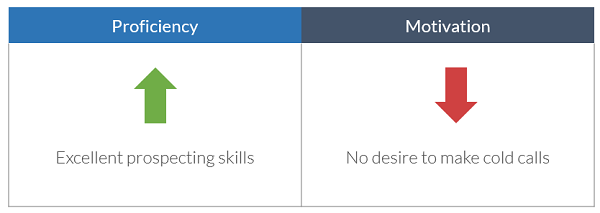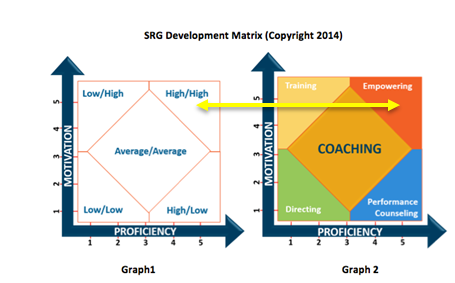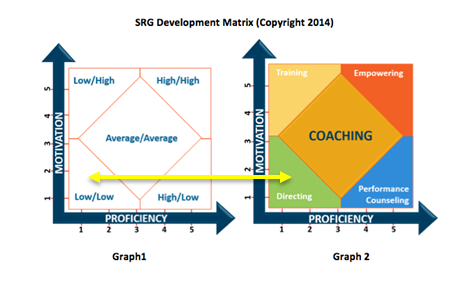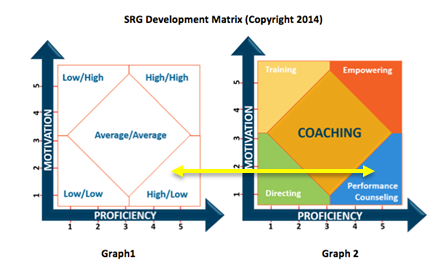ATD Blog
When NOT to Use Sales Coaching
Wed Oct 29 2014


The reason both dimensions (proficiency and motivation) are important is that the combined assessment points to the action the manager should take to address the skill gap.
By plotting these skills on a matrix, managers can readily determine what skills to coach, generally where proficiency and motivation are average (see Graph 1); and what other actions such as directing, training, counseling, and empowering, sales managers should consider when skills require more than coaching (see Graph 2).

This Development Matrix assumes that you first conduct a comprehensive skills assessment of a salesperson on a 1-5 scale. Let’s see how the Development Matrix can quickly help you determine when coaching is the appropriate management action to improve skills.
Empowering (High/High)
Assume you have a salesperson on your team who is a great negotiator, rating extremely high in both proficiency and motivation. Here we recommend that the appropriate management action is empowerment, not coaching. In other words, you should increase this salesperson’s control and accountability.

For example, you can do this by expanding the salesperson’s initiative by letting them manage a complex negotiation without your direct involvement.
The benefit to you is that by shifting more responsibility to a highly skilled and motivated salesperson, you create “leverage” by having the salesperson do more of the work (and solving their own problems), thus freeing up your own time.
Caution: some managers have trouble letting go and truly empowering a salesperson, so be careful not to empower with one hand but then take away with the other by micro-managing the details.
Training (Low Skill/High Motivation)
Often with new salespeople we find that they aren’t proficient in many skills, but are nonetheless highly motivated. In these cases, coaching isn’t effective because these salespeople don’t yet have a baseline level of proficiency. Instead, training is the most effective management action to improve skills.

Training differs from coaching in that it tends to be much more structured and less customized than coaching. Sales training is typically done in small groups, not one-to-one, although ramping up new salespeople may be an exception to this rule. Also, remember that most adult learners forget 80 to 85 percent of what they learn within 30 days of a training event. So, to make training effective, you must follow it up with on-going reinforcement, including coaching.
Directing (Low Skill/Low Motivation)
When a specific skill rates low in both proficiency and motivation, you need to direct, not coach. That means give specific orders or instructions on how, what, and when to accomplish a task. In other words, you are telling the salesperson what to do.

As a manager, there are many times when it is appropriate to direct, including when someone is new in their position. That being said, having to continually direct a salesperson is a very inefficient use of time, and it should be used sparingly with high performers who typically don’t like to be micro-managed.
Performance Counseling (High Skill/ Low Motivation)
Performance Counseling is appropriate when the salesperson has previously demonstrated high proficiency in a certain skill, but for whatever reason now has low motivation. One common skill area in which we see this is prospecting.

With Performance Counseling, your goal is to investigate and intervene to address motivational or attitudinal issues that negatively impact job performance. Performance Counseling is a complex management action that requires great care. Of course, always contact your HR department before attempting Performance Counseling, and be sure to keep the conversation focused on observable behaviors, not judgments.
Coaching (Average Skill/Average Motivation)
Coaching is the most common management action to develop selling skills because coaching assumes a baseline level of proficiency and is great for fine tuning skills. That is why the “Coaching Diamond” takes up the most area on the Development Matrix.

The reason coaching is so powerful is that as skills go from “average” to “high” they move to the Empowerment quadrant, freeing up your time.
While coaching can’t address every development need, it is highly effective in improving “average” skills. For any sales manager interested in becoming a better sales coach, the Development Matrix is powerful tool that will help you quickly determine the appropriate development action for improving the skills of your salespeople, including when to coach.
If you would like more information on this topic, please download our whitepaper, Sales Coaching for Improved Performance.
**[
If you want to maximize the performance of your sales team, there is almost universal agreement that you must master the skill of Sales Coaching. This makes sense because sales coaching provides the greatest point of leverage when it comes to improving sales team effectiveness.
Even a small improvement in quota attainment can make a huge difference when you multiply that by seven to 10 sales reps (the typical number of direct reports for a sales manager). But there are cases when sales coaching is not an appropriate management action.
Sometimes we assume coaching can solve any problem. Unfortunately, that’s not the case. For example, you don’t coach someone who is chronically late to work.
So how can a manager systematically identify skills and behaviors that are best addressed by coaching rather than by other management actions?
Start by assessing the skills of your salespeople. When assessing sales skills, it is helpful to think about this from both a proficiency and motivation standpoint. A skill gap based on proficiency would typically involve a salesperson not being able to perform a skill because they don’t know how, whereas motivation gets to a lack of desire.
As an example, a seasoned sales professional may have: excellent prospecting skills (high proficiency) but absolutely no desire to make cold calls (low motivation).
](http://www.salesreadinessgroup.com/)** [](http://www.salesreadinessgroup.com/)
You've Reached ATD Member-only Content
Become an ATD member to continue
Already a member?Sign In
